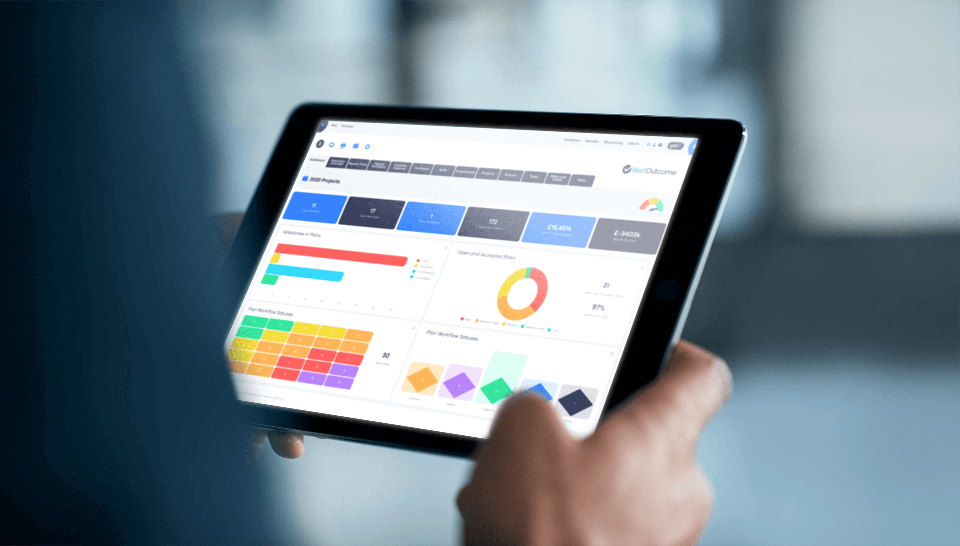This is a step-by-step guide showing you how to set up a PMO office. Learn how to unlock the power of a project management office with this in-depth resource.
Before we get started…
PMO stands for project management office (hence the often misused term ‘PMO Office’), the responsibilities of a PMO is to manage projects, programmes and portfolios across the organisation.
In this blog we have identified 6 key steps to setup your PMO successfully.
There are many different types of PMO in existence. Some of these are what we call ‘value adding’ and some are more ‘admin centres’. For a PMO to deliver real benefit it needs to be a value-adding one.
For more information on how to create a value-adding PMO, please view this Bestoutcome blog:
How To Transform Your PMO From Box Tickers To Value Adders

We need to start by identifying what purpose and value your PMO will bring the organisation. PMOs will typically take three different forms:
1. Supportive – Very much administrative, providing support, documentation and administration capability to projects.
This form of PMO allows projects to have a relative amount of flexibility to deliver in a way that suits and the PMO is relatively passive.
2. Controlling – Setting and enforcing standardisation across projects in the organisation.
This type of PMO is the ‘custodian’ of project standards and methods across the organisation. It often recommends or prescribes toolset and reporting standards that all Projects must adhere by.
3. Directive – This PMO will be the central source for not only documentation, methodologies, tooling but also managing resources and capacity.
The PMO will manage resource pools or liaise with a set of resource managers to allocate the right resources to each project.
The PMO will also identify any shortfall in resources that are needed to deliver the overall portfolio.
They will also provide a high level of guidance and Quality Assurance to all projects.
This suits organisations with a need for exceptionally tight control on projects.
Before setting up your PMO organisation and ‘type’, the PMO lead will need to liaise with key stakeholders and sponsors to understand what type of PMO the organisation requires.
The types of PMO listed above may be determined by the maturity of the organisation.
For example, in type 3, the Directive PMO, the organisation has to be at a certain level of maturity to be able to do resource management properly.
The type of PMO may also be dictated by sector and the regulations in that particular sector, e.g. Pharmaceuticals or Financial Services.
Once you have agreed with the Sponsor on the objectives of the PMO and the high-level requirements, you will now need to think about the services provided from the PMO.

According to the Association of Project Management, project sponsors are business leaders who play a key role in promoting, advocating and shaping project work.
They oversee the project and programme management functions and remain accountable for ensuring the realisation of the specified benefits over time.
From our experience in setting up PMOs, the sponsor is perhaps the most important cog in the machine to ensure you have a fully functioning team. As each project and programme needs an active sponsor so does creating and then operating the PMO.
Be a Change Champion!
The sponsor is the champion of the project or programme. He or she has a vested interest in its success.
However, the sponsor must also check the ongoing viability of the project or programme at various stage gates or intervals.
Despite being the change champion, the sponsor must also recognise when the project or programme is no longer justifiable if the business case becomes unviable.
This may happen as more information on the costs, risks and benefits are understood as the project progresses.
Support the Project Manager
The sponsor needs to challenge the project manager as to the progress, risks, issues, cost, and expected benefits.
This needs to be a ‘healthy challenge’. However, running a project or programme successfully can be a difficult undertaking and the sponsor needs to be supportive of the project or programme manager when difficulties arise.
Unblocking Blockers!
During any project, hurdles and uncertainties will occur. Some of these obstacles may not be within the project manager’s ability to overcome.
This may be due to a lack of seniority or lack of influence in another part of the organisation.
The project may encounter some barriers to change in a different department and the sponsor needs to get involved to overcome these barriers.
The project may, for example, require more resources to deliver the project’s outcomes. Unlocking blockers and allocating more resources are key parts of a sponsor’s role.

Now, Step 3 isn’t as straight forward as the first two, the reason being – Variability! The methodology, tools and process you use are totally dependant on you and your organisation.
Often when speaking with potential customer for our PPM tool, PM3, they think they want an all singing, all dancing PPM platform that can do everything for them…including making them a cup of tea.
In reality, these organisations sit low on the maturity scale and therefore even if they did have all the functionality they required they wouldn’t be able to leverage that effectively.
So be careful choosing the methodology, tools and processes you put in place and the key question when deciding these is – ‘Do they align with our maturity?’.
Putting a methodology in place can definitely help to move you up the maturity curve. You must be purposeful and have a complete plan in mind to get there and, not rely purely on a tool, methodology or a process.

It’s important you begin with setting out the key roles and responsibilities within the PMO team. This also includes engagement models with the rest of the organisation.
Now, at the setting up stage we don’t want to run before we can walk. We must ensure that we expand with maturity and ensure that the team grows with the right skillsets.
It’s important to have a plan of an ideal state of a team, going back to the maturity scale you may say in 2 years’ time at a level of maturity we will be ready for 10 full time staff but at this moment in time we are fine with 3.
Ramping up at the appropriate pace for the organisation is key.

Communication is key in all walks of life. Especially so within a PMO organisation. The reason being is this will impact the reputation of the PMO throughout the business.
You must have a communication plan and be clear on how you connect to the various stakeholders in the business from Project Managers to Finance to HR.
This must take into account frequency and format of communications and who from the PMO team makes these communications.
It’s also important that you are clear how you communicate with your project teams and the level of communication/engagement they should expect from the PMO.

Reporting is one of the key metrics and outputs that can come from a PMO. Reporting, is also one of the frustrations for the Project Manager. It is important that the PMO create a clear reporting plan, what we like to call a Drumbeat of reporting.
This needs to be predictable in its format, cadence and audience.
I was contacted recently by a client who had just resigned as PMO lead because he had no sponsorship from the IT leadership team.
My initial reaction was surprise that a PMO for a relatively large organisation was not considered valuable.
However, after some reflection and a brief conversation, I realised that the PMO in question was a project management office and not a portfolio management office.
I categorise the former as one where the PMO is more of an administration function that is focussed on timesheet management and cost reports.
A portfolio management office has quite a different focus from a project management office. The latter typically is engaged in:
As you can see, a portfolio management office is not obsessed with timesheet management but is more focussed on working with the leadership team to first develop and then manage the right organisational portfolio.
Prioritising the projects that should be delivered using sensible evaluation criteria is by definition a high value-added activity.
Once the portfolio is created then there is the on-going PMO role to add new projects that are right for the organisation and also terminate projects that no longer meet the needs of the organisation.
Many portfolio offices run a Quality Gate or toll gate process to ensure that projects in the portfolio should still be delivered.
We are seeing more and more clients transforming PMOs from the project management or administration model to the more value-adding portfolio management office.
A portfolio management office should be easily justified in terms of cost/benefit if it helps an organisation deliver the right portfolio of projects.
The old model of where pet projects get delivered at the expense of more value-adding projects is very hard to maintain when there is a portfolio management office responsible for the project portfolio.

Our products help you deliver successful change programmes and projects by always focusing on the overall business outcomes. Find out how our products can help you.
Tell Me More Request a DemoOver the last 20+ years I've tracked the overall competency of organisations to deliver projects suc...
Read more >The majority of PMOs that are, what we call ‘value-adding’ PMOs, will need to produce dashboards...
Read more >